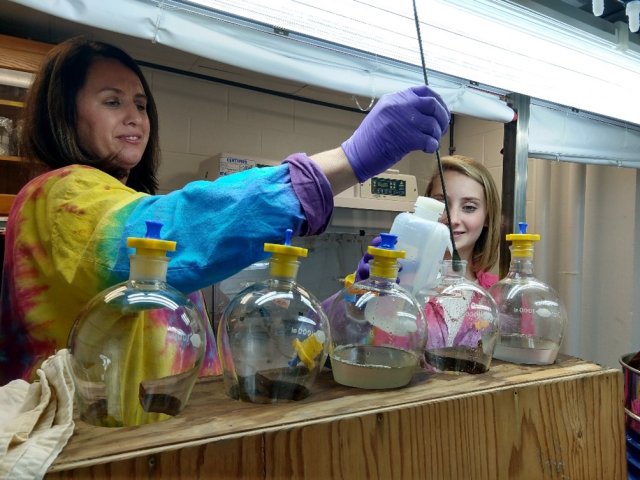Making Microplastic Identification More Accessible

Published May 24, 2022
Imagine trying to count hundreds, thousands, even millions of tiny particles that are too small to see with the human eye. Now, imagine those tiny particles could be any shape, size, or color and are covered in mud. That’s a challenge that EPA chemist Michaela Cashman, Ph.D. and other EPA researchers are taking on in their microplastics identification research.
Microplastics are microscopic pieces of plastic that break down from common plastic materials, such as food wrapping, tires, and synthetic fabrics, and end up in our environment. The majority of these microplastics get washed away by rain, enter watersheds, and eventually end up in marine sediments. Sediments are under almost every water body and are primarily organic and mineral matter. They are important ecosystems and a major sink for contaminants but are often overlooked because they exist below the surface.
The accumulation of microplastics in sediments likely has ecological and human health ramifications, but much is still unknown about how much microplastic is out there and its impact on human health and the environment.
“What concerns us is that everywhere we look–arctic, deep-sea trenches, human plasma–we find plastic. The more we look, the more we find,” says Cashman, the lead author on a recent EPA-led study that developed a new method for identifying microplastics.
“Given the variety in plastics, there is no standard or ‘one size fits all’ method for quantifying microplastics in environmental samples. It makes it difficult to compare data and results of various studies when there are hundreds of methods used across the world.”
A Hybrid Method for Identifying Microplastics in Sediment
Researchers at EPA recently developed a new method for identifying and counting microplastics in environmental sediment samples, which they call the hybrid method because it combines elements of other methods to get the most accurate results possible.

The method involves two main steps: (1) extraction, the process of separating particles from the sediment; and (2) analysis, the process of determining whether each of the individual extracted particles are made of plastic so the total number of plastic particles can be counted.
EPA researchers first extract the particles by shaking a sample of sediment in a salty solution. Since plastic is less dense than sediment, microplastic particles initially float while sediment sinks, allowing for the separation of plastic particles from sediment.
Researchers then analyze the extracted particles under a microscope to count the number of microplastics per sample. Other materials, such as algae, are often mixed in, so different processes are needed to confirm if a particle is plastic. In this study, researchers used a piece of equipment called a Raman Spectrometer, which shoots a spectrum of light at a sample and can confirm whether a particle is made of plastic based on the returning wavelength.
Applying the Hybrid Method to Quantify Microplastics
Cashman and colleagues recently used the hybrid method in a case study in Narragansett Bay, Rhode Island. They collected sediment samples from seven sites and found 38 different types of plastic. The most abundant type was cellulose acetate, which has industrial use, including fiberglass for boats, textiles, and cigarette filters. Other microplastic polymers found included polyester, polypropylene, methyl cellulose, polyurethane, polystyrene, polyethylene, ethyl cellulose, and polyvinyl chloride (PVC).
What they found most surprising was that one site had extremely high microplastic content at 4.6 million pieces of plastic per 100-gram sample; nearly all of which was cellulose acetate. The other six sites had 40 – 293 pieces of a variety of types of plastic per 100-gram sample, which is a much more typical range of microplastic quantity and polymer type. Researchers were not able to identify the source of the highly abundant cellulose acetate at the one site but believe it could be from the manufacturing of textiles used the boating industry.
The variation in both the type of plastic and the quantity of microplastic particles in this small case study demonstrates the vast variability of microplastics throughout the global environment and the need for improved methods for researching microplastics.
The hybrid method developed and applied in this research can help make microplastics research more standardized and accessible. “The method is easy to use and set up; anyone with a basic lab set-up can recreate it. Accessibility of this method is important for universities, non-governmental organizations, and other entities. Having these more robust methods will get us closer to understanding how extensive plastic is in our Nation’s water resources,” says Cashman.
“There’s so much we don’t know. The more we look, the more we find. The better we get at finding what’s out there, the better we’ll get at developing solutions to protect our environment.”
Learn more:
- Microplastics Research
- Cashman, M., T. Langknecht, D. El Khatib, R. Burgess, T. Boving, S. Robinson, and K. Ho. (2022). Quantification of microplastics in sediments from Narragansett Bay, Rhode Island USA using a novel isolation and extraction method. Marine Pollution Bulletin, 174:113254.
- Cashman, M., K. Ho, T. Boving, S. Russo, S. Robinson, and R. Burgess (2020). Comparison of microplastic isolation and extraction procedures from marine sediments. Marine Pollution Bulletin, 159:111507.
